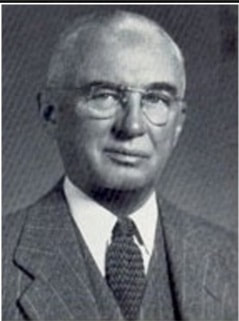|
Alex F. Osborn: Enhancing Creative Thinking Skills (By Lauritz Huthchinson)
While the earliest approaches to creative problem solving (CPS) can be traced to studies in the 1940s, any reference to CPS will invariably lead to Alex Osborn who in 1953 introduced the CPS process and the brainstorming tool to enhance and facilitate groups’ and individuals’ creative thinking skills (Puccio, Mance, & Murdock, 2011). In his seminal work Applied Imagination: Principles and procedures of creative problem-solving (1953), Osborn developed CPS as a seven-stage process as shown in Figure 1. The stages were: orientation, preparation, analysis, hypothesis, incubation, synthesis, and verification (Isaksen & Treffinger, 2008). Osborn further developed CPS simplifying it into a three-stage model: fact finding- problem definition, data gathering and analyzing; Idea-Finding- idea production and development; and Solution Finding- evaluation and adoption (Osborn, 1963). In the 1960s Parnes and his colleagues further modified Osborn’s CPS model which came to be known as the Osborn-Parnes approach to creative problem solving (Isaksen & Treffinger, 2008). Figure 1: Osborn’s Creative Problem Solving Model Brainstorming Osborn is also credited with the origination of the creative thinking tool brainstorming (Vehar, Firestien, & Miller, 1997). Brainstorming has been used to help groups engage in effective idea generation. Osborn stressed the importance of withholding criticism to allow ideas to flow. Thus, Osborn introduced four ground rules for group brainstorming: no criticisms of ideas; go for large quantities of ideas; build on each other’s ideas; and encourage wild and exaggerated ideas. These four guidelines provide the basis for the ground rules of divergent (generating a diverse set of alternatives) and convergent thinking (screening, selecting and evaluating alternatives). This dynamic balance between divergent and convergent thinking is the hallmark of CPS. The Essence of Alex Osborn ideas What is remarkable, even radical (Puccio & Keller-Mathers, 2007) about Osborn’s core beliefs about creativity was that he departed from standard views of many that creativity could not be nurtured and only certain people possessed the innate talent to be creative. Osbourn argued that creative potential was universal and that creative thinking and problem-solving were skills everyone could develop. As Osborn (1952b) suggested: “Each of us does have an Aladdin’s lamp, and if we rub it hard enough, it can light our way to better living – just as that same lamp lit up the march of civilization” (p. 8). Osborn’s core belief regarding individuals’ imagination points to the fact that human beings are capable of being creative, but it is a matter of accessing it deliberately (Wheeler, para. 5, n.d.). Osborn has left a legacy in the area of applied creativity. His CPS framework has allowed for research to develop the CPS process into different interpretations and application (Isaksen, Dorval, & Treffinger,1994). His works and theories have made him one of the founding fathers of creativity research and have garnered him the title of “father of creativity. For example, since its publication in 1953, Applied Imagination has become one of the most widely known books on the subject of creativity. The fact that this book is over 50 years old points to its enduring value in the emerging field of creativity. References Center for Studies in Creativity Buffalo State. (2015). Alex Osborn creative pioneer. Retrieved from https://creativity7.wixsite.com/alexosborn Isaksen, S.G., Dorval, K. B., & Treffinger, D. J. (1994). Creative approaches to problem solving. Dubuque, IA: Kendall/Hunt. Isaksen, S.G. & Treffinger, D. J. (2008). Celebrating 50 years of reflective practice: Versions of creative problem solving. Retrieved fromhttp://cpsb.com/research/articles/creative-problem-solving/Celebrating-50-Years-of-Creative-Problem-Solving.html Osborn, A. F. (1921). A Short course in advertising. New York: Scribner’s. Osborn, A. F. (1948). Your Creative Power: How to Use Imagination. New York: C. Scribner’s Sons. Osborn, A. F. (1952a). Wake up your mind: 101 ways to develop creativeness. New York: Scribner’s. Osborn, A. F. (1952b). Your creative power: How to use imagination. New York: Scribner’s. Osborn, A. (1953). Applied Imagination: Principles and procedures of creative problem-solving. New York: Scribner’s. Osborn, A. (1955). The Goldmine Between Your Ears. New York: Scribner’s. Osborn, A. (1963). Applied Imagination: Principles and procedures of creative problem-solving (3rd ed.). New York: Scribner. Puccio, G. J., & Keller-Mathers, S. (2007). Enhancing thinking and leadership skills through creative problem solving. In A.G. Tan (Ed.), Creativity: A handbook for teachers (pp. 281-301). Hackensack, NJ: World Scientific Publishing. Puccio, G. J., Mance, M., & Murdock, M. C. (2011). Creative leadership: Skills that drive change. Sage Publication. Vehar, J., Firestien, R., & Miller, B. (1997). Creativity unbound. Williamsville, NY: Innovation Systems Group. Wheeler, W. S (n.d.). Alex F. Osborn: The father of brainstorming. Retrieved from russellawheeler.com/learning_zone/alex_f_osborn/
0 Comments
|



 RSS Feed
RSS Feed
